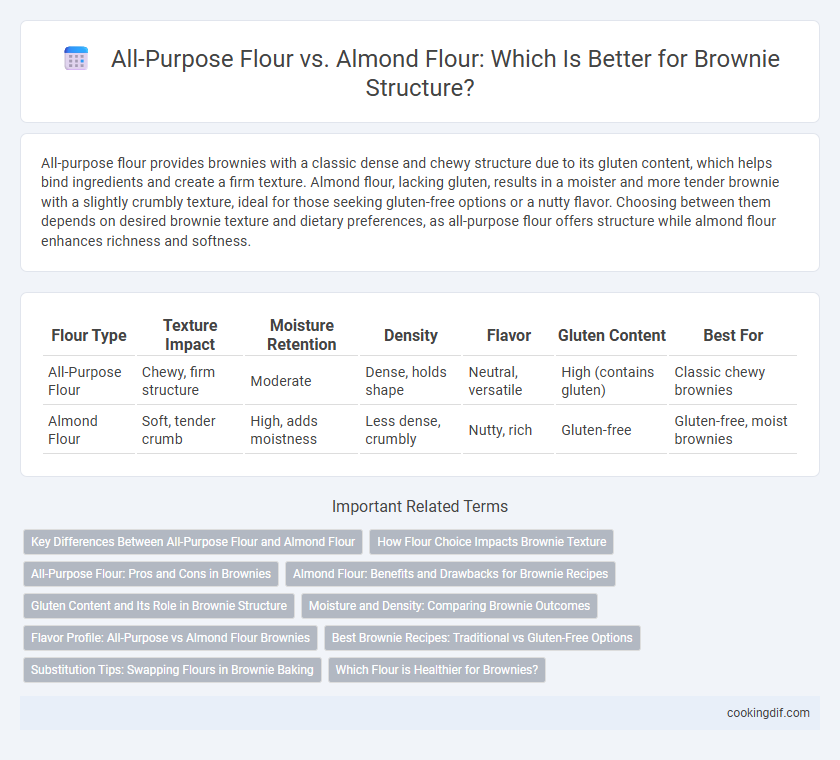All-purpose flour provides brownies with a classic dense and chewy structure due to its gluten content, which helps bind ingredients and create a firm texture. Almond flour, lacking gluten, results in a moister and more tender brownie with a slightly crumbly texture, ideal for those seeking gluten-free options or a nutty flavor. Choosing between them depends on desired brownie texture and dietary preferences, as all-purpose flour offers structure while almond flour enhances richness and softness.
Table of Comparison
| Flour Type | Texture Impact | Moisture Retention | Density | Flavor | Gluten Content | Best For |
|---|---|---|---|---|---|---|
| All-Purpose Flour | Chewy, firm structure | Moderate | Dense, holds shape | Neutral, versatile | High (contains gluten) | Classic chewy brownies |
| Almond Flour | Soft, tender crumb | High, adds moistness | Less dense, crumbly | Nutty, rich | Gluten-free | Gluten-free, moist brownies |
Key Differences Between All-Purpose Flour and Almond Flour
All-purpose flour provides a dense, chewy texture in brownies due to its high gluten content, which creates a strong, elastic structure. Almond flour, being gluten-free and made from finely ground almonds, results in a moister, softer brownie with a slightly crumbly texture and richer flavor profile. The protein and fat differences between all-purpose flour and almond flour significantly impact the final brownie's structure, moisture, and mouthfeel.
How Flour Choice Impacts Brownie Texture
All-purpose flour provides a dense and chewy texture in brownies due to its higher gluten content, which forms a strong network during baking. Almond flour, being gluten-free and rich in fat, results in a moister and more tender crumb with a slightly crumbly structure. Choosing between all-purpose and almond flour directly impacts the brownie's firmness and mouthfeel, influencing whether the final product is fudgy or cakey.
All-Purpose Flour: Pros and Cons in Brownies
All-purpose flour provides a chewy and dense texture to brownies due to its moderate gluten content, making it ideal for traditional fudgy or cakey brownies. It offers consistent structure and rise, ensuring the brownie holds together well during slicing and serving. However, excessive gluten development can result in a tougher brownie if overmixed, and it lacks the nutty flavor and lower carb benefits found in almond flour.
Almond Flour: Benefits and Drawbacks for Brownie Recipes
Almond flour enhances brownie recipes by providing a moist, rich texture and a subtle nutty flavor, making it a popular choice for gluten-free and low-carb diets. Its higher fat content contributes to a tender crumb but may result in a denser, less chewy structure compared to all-purpose flour. However, almond flour's lack of gluten limits the rise and elasticity, requiring recipe adjustments like extra binding agents to achieve optimal brownie consistency.
Gluten Content and Its Role in Brownie Structure
All-purpose flour contains gluten, a protein that provides elasticity and structure to brownies by forming a network that traps air and moisture, resulting in a chewy and dense texture. Almond flour is gluten-free and made from finely ground almonds, which leads to a denser and more crumbly brownie structure due to the lack of gluten's binding properties. Understanding the role of gluten content helps bakers choose the right flour to achieve their desired brownie texture, balancing chewiness and moisture retention.
Moisture and Density: Comparing Brownie Outcomes
All-purpose flour contributes to a denser, chewier brownie texture due to its higher gluten content, which traps moisture and provides structure. Almond flour results in a moister, softer brownie with a tender crumb because it contains more fat and less gluten, reducing overall density. Choosing all-purpose flour enhances firmness and bite, while almond flour produces a rich, moist treat with a delicate, crumbly texture.
Flavor Profile: All-Purpose vs Almond Flour Brownies
All-purpose flour brownies have a classic, dense texture with a neutral, slightly sweet flavor that highlights chocolate richness. Almond flour brownies offer a moist, tender crumb infused with a subtle nutty taste that enhances the overall depth and complexity. The choice between these flours significantly alters the flavor profile, with almond flour providing a distinctive, gourmet twist compared to the traditional, straightforward taste of all-purpose flour.
Best Brownie Recipes: Traditional vs Gluten-Free Options
All-purpose flour provides the classic chewy texture and dense structure essential in traditional brownie recipes, delivering a rich, fudgy bite. Almond flour, commonly used in gluten-free brownies, creates a moist, tender crumb with a slightly nutty flavor but often results in a lighter, more delicate texture. Choosing between all-purpose and almond flour depends on dietary needs and desired brownie consistency, with almond flour ideal for gluten-free options and all-purpose flour best for authentic flavor and structure.
Substitution Tips: Swapping Flours in Brownie Baking
All-purpose flour provides a dense, chewy texture in brownies due to its high gluten content, while almond flour yields a moist, tender crumb with a slightly nutty flavor and lower gluten structure. When substituting almond flour for all-purpose, use a 1:1 ratio but expect a softer, more delicate brownie that may require additional binding agents like eggs or flaxseed to maintain shape. For optimal structure, reduce baking time slightly and consider blending almond flour with a small amount of all-purpose flour or a gluten-free binder to achieve a balanced, rich brownie consistency.
Which Flour is Healthier for Brownies?
All-purpose flour provides a traditional, dense structure in brownies but is higher in carbohydrates and lacks essential nutrients compared to almond flour. Almond flour offers a moist, crumbly texture with added protein, healthy fats, and fiber, making it a nutrient-rich, lower-carb alternative ideal for gluten-free baking. Choosing almond flour enhances the brownie's health profile by reducing glycemic impact and increasing vitamin E and magnesium content.
All-purpose flour vs Almond flour for brownie structure Infographic

 cookingdif.com
cookingdif.com